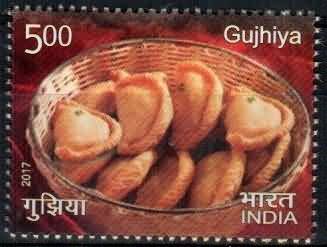Festival Cuisine – Gujhiya

Technical Data
| Stamp Set | Indian Cuisine |
|---|---|
| Date of Issue | November 3, 2017 |
| Denomination | Rs. 5 |
| Perforation | 13¾ |
| Printer | Security Printing Press, Hyderabad |
| Printing Process | Wet Offset |
| Watermark | No Watermark |
| Colors | Multicolor |
| Credit (Designed By) | Sh. Brahm Prakash |
| Catalog Codes |
Michel IN 3236 Yvert et Tellier IN 2927 Stanley Gibbons IN 3380 |
| Themes | Food | Gastronomy |
Indian festivals are incomplete without traditional sweets that bring families together in celebration. Among these, Gujhiya holds a special place as a festive delicacy cherished across northern and central India. Recognised in the Festive Cuisine category of the commemorative postage stamp series released by the Department of Posts, Gujhiya reflects the joy, flavour, and cultural essence of Indian festivities.
A Traditional Sweet of Festive Celebrations
Gujhiya is a sweet, crescent-shaped dumpling traditionally prepared during festivals such as Holi, Diwali, Teej, and other joyous occasions. It symbolises abundance, happiness, and the arrival of festive cheer. The preparation of Gujhiya often turns into a family activity where homes are filled with the aroma of roasted khoya, ghee, and dry fruits.
A Delectable Blend of Richness and Flavour
The outer covering of Gujhiya is made using suji (semolina), maida (refined flour), or whole wheat flour, shaped into pastry-like pockets. The filling is a delicious mixture of roasted khoya (mawa), grated coconut, sugar, cardamom powder, and an assortment of dry fruits like almonds, cashews, and raisins. Once filled and sealed, Gujhiyas are deep-fried to a golden crisp and sometimes dipped in sugar syrup for an added glaze and sweetness.
A Sweet with Cultural Roots Across India
While Gujhiya is most popular in states such as Uttar Pradesh, Bihar, Rajasthan, Madhya Pradesh, and Delhi, many regional variations enrich its legacy.
Some well-loved versions include:
- Pedakiya (Bihar) – Often offered as prasad during Chhath Puja
- Ghughra (Gujarat) – Similar preparation with subtle regional flavour variations
- Karanji (Maharashtra) – A coconut-rich variation enjoyed during Diwali
Each adaptation retains its festive essence while adding its own regional touch.
Symbol of Festive Joy and Tradition
Gujhiya is more than just a sweet dish. It represents:
- The joy of festive preparation shared among family members
- The warmth of Indian hospitality
- The continuation of culinary traditions passed down through generations
Its presence in the commemorative stamp series celebrates its cultural importance and its role in enriching India’s festive food heritage.
Conclusion
Golden, crisp, and filled with flavours of festivity, Gujhiya is a cherished celebratory sweet that perfectly captures the spirit of Indian festivals. Its inclusion in the postage stamp collection honours its traditional value and the delightful sweetness it brings to every household.
